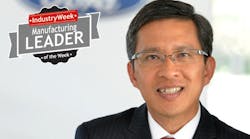Building Better Supplier Relationships at Ford
Hau Thai-Tang took an unusual path to his current role at Ford. Instead of working his way up the ranks of purchasing, he spent 25 years on the engineering and product development side, leading the launch of the 2005 Mustang, working as a race engineer on Ford’s 1993 IndyCar team, and spending four years leading product development for Ford South America.
So when Thai-Tang became the vice president of global purchasing in 2013, he had to do a little more handholding with suppliers than his predecessors. He had to reassure them that yes, he knew the job, having worked very closely with purchasing as a lead engineer, and yes, Ford was still committed to One Ford--its plan to align operations to become more efficient and take advantage of economies of scale.
When One Ford was implemented in 2007, the company had 27 global platforms. Now it’s down to eight. “That’s giving us a lot of economies of scale … and that results in savings that doesn’t come out of the profit margins of our suppliers, ” says Thai-Tang.
Ford started working on building a “collaborative working relationship” with its supply base after the financial crisis of 2008. The automaker’s purchasing model focuses on long-term development and purchasing agreements with select suppliers, and spells out business practices like upfront payments and data transparency.
“It was modeled after some of the best practices in the industry,” says Thai-Tang. “It’s not about sourcing to the lowest-cost bidder on something that’s very much a true commodity … It’s more, 'Who are our long-term strategic partners that we want to align ourselves with, that we want to count on to help us innovate?'”
Thai-Tang says three things have worked especially well for Ford in terms of supplier relationships. One is the clarity of what the Ford brand stands for: quality, green, safe and smart.
“We have tremendous alignment within Ford between the marketing and sales team, the product development team and the purchasing team,” says Thai-Tang. “Those brand pillars help us communicate to our suppliers what sort of technologies and product innovation we’re interested in. It helps them prioritize their investment, their R&D spending, and where they should allocate resources.”
The second element, says Thai-Tang, is that when Ford finds a technology that fits into its mission, it deploys it “very broadly. Some companies only do the very high-end luxury products, and then they count on the trickling down over time. The Ford approach is, ‘Hey, if it’s aligned with our brand pillars, we should do it across all of our products.’”
For instance, Ford’s EcoBoost engines were not the first direct-injection turbo charged gas engines on the market, “but we were the first to say, ‘This is really aligned with our green strategy, so we’ll offer it across all of our product lines.”
Ecoboost is available on more than 90% of Ford products globally. “That gives our suppliers a lot of volume and scale and profit opportunities,” Thai-Tang says. “So if you’re a supplier and you’re spending a large chunk of your income on R&D spending, one of the things that’s very attractive is how much volume and revenue potential you can get for that new idea, and that allows you to amortize your fixed costs, your initial spending quicker.”
The third benefit, says Thai-Tang, “is we do a really good job of marketing the technology to consumers, generating the interest and demand.”
Sometimes, like with the F-150 shifting from a steel body to unitized aluminum, developing the supply base has meant both finding suppliers for the high-strength aluminum alloy (Alcoa and Novelis) and also working with the non-production suppliers to change over their manufacturing processes.
“Instead of welding the bodies together, we had to use mechanical fasteners—self-piercing rivets with adhesives,” says Thai-Tang.
Another kind of supplier development happens when Ford sets up shop in new markets. In India, says Thai-Tang, Ford set up an assembly and a powertrain plant “to take advantage of the low-cost labor and get more of our cost basis denominated to rupees just to give us a hedge against any currency fluctuations. To do that, you really have to develop a local supply base.”
If a technology was globally common or could be duplicated in other parts of the world, Ford asked its global suppliers “to localize and establish a footprint in India with us.”
But in some cases, Ford wanted to find new suppliers in India. Typically, a new supplier takes about three years to develop, sometimes more, he said.
“They may be providing services to some of the indigenous manufacturers there, and then it’s a matter of getting them up to the same capability, whether it’s standard specifications or quality that would make them a good partner,” says Thai-Tang.
Some Indian suppliers were already global. “Motherson is a great example,” he says. “They already had aspirations to grow outside of India and didn’t require a lot of development. In some cases, we found suppliers who were not yet in automotive. They may have been doing wiring harnesses for the appliance industry, or for motorcycles. And getting them scaled up and capable of supplying Ford required more development and more work.”
From working on both the product development and purchasing sides, Thai-Tang says he’s learned that it’s best to engage suppliers very early in the design process: “Talk with them about what is the customer problem that we’re trying to solve, and how do we collaborate to get to the best design cost and ensure that they make a fair margin. Then we’re actually leveraging their knowledge, their expertise, and learning from their best practices based on all the customers they serve.
“It’s not doing it all ourselves and giving them a drawing and saying, ‘How much for this part?’ It’s saying, ‘This is a problem I’m trying to solve. How would you guys go about doing it, and how would we work together to get the best value?’”





